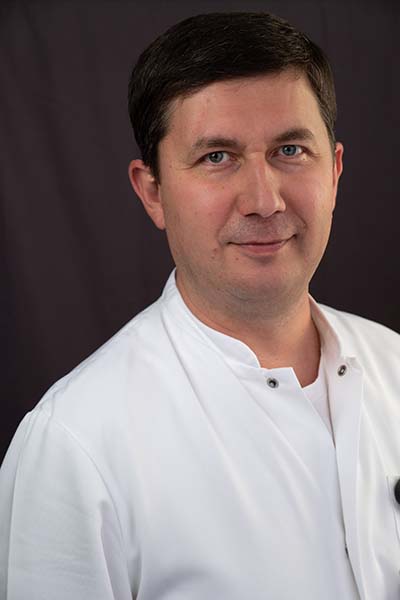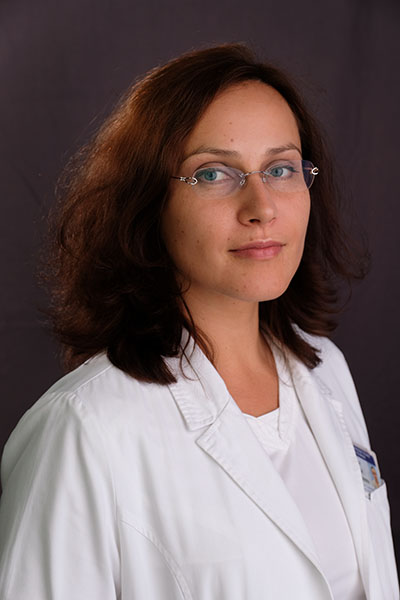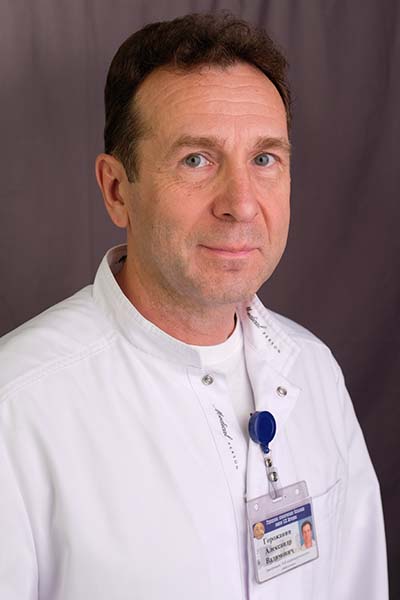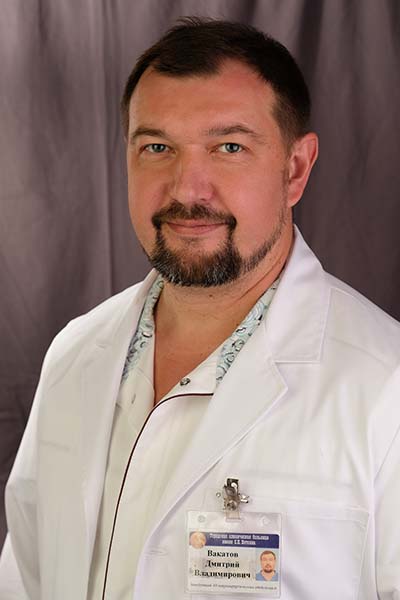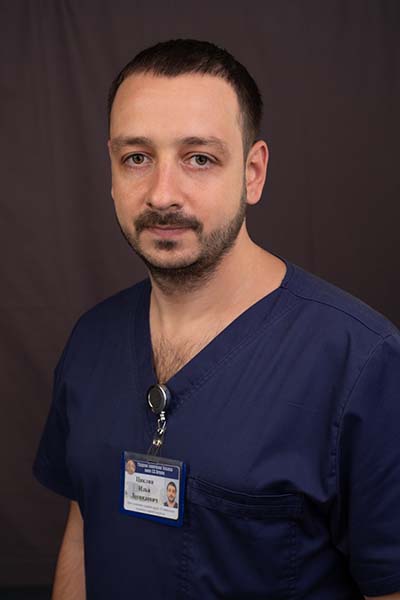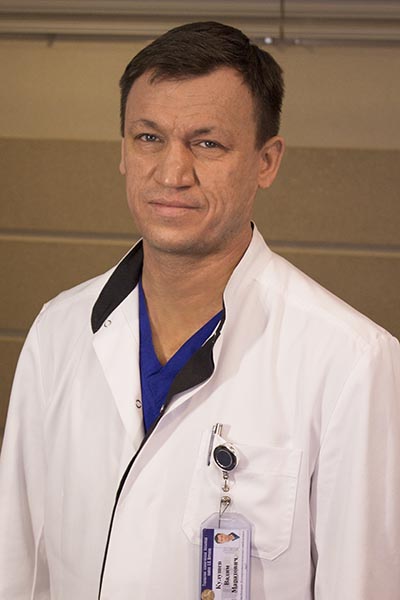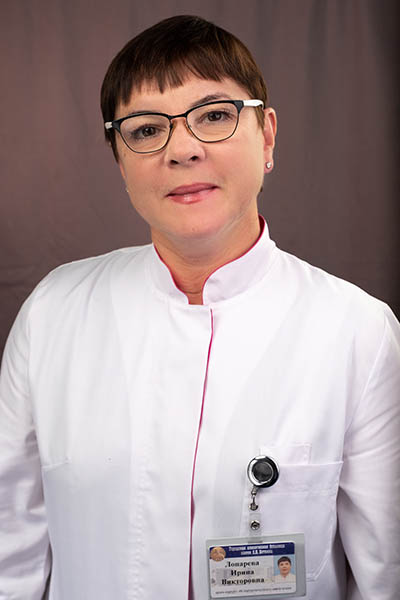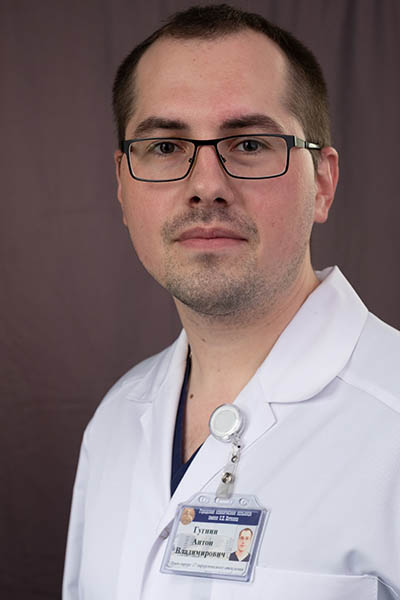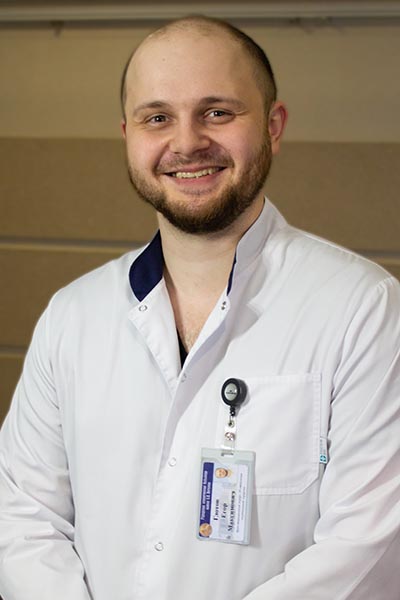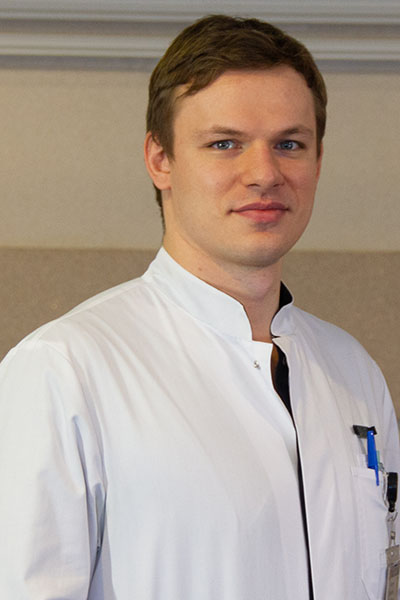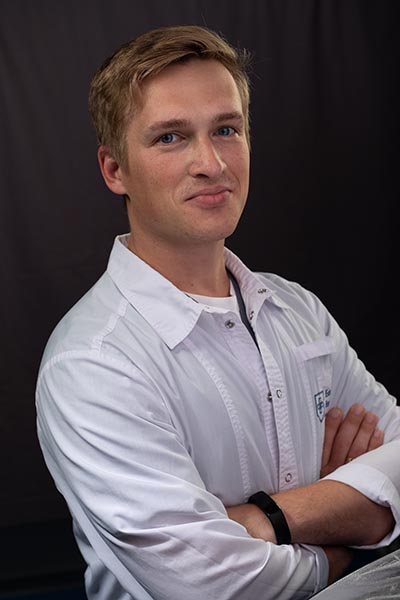Surgery


The surgical service of the hospital is represented by clinics of surgery, urology, gynecology, cardiovascular surgery, traumatology, neurosurgery, ophthalmology, otorhinolaryngology and maxillofacial surgery. Every year, the hospital specialists perform more than 40 thousand operations, of which about 10 thousand are classified as high-tech medical care. In most cases, minimally invasive medical technologies, endoscopic interventions and operations under the control of x-ray equipment and computer navigation are used.
In the clinic of surgery at the Botkin hospital 6 offices. The Department of liver and pancreatic surgery, as well as the 17th surgical Department, specialize in the treatment of abdominal organs and abdominal Oncology. The Department of endocrine surgery specializes in the surgical treatment of diseases of the endocrine system and breast. Department of thoracic surgery is focused on the treatment of surgical pathology of the chest. Department of Coloproctology clinic deals with the treatment of diseases of the colon. The priority of all departments of the clinic of surgery is to perform operations from low-traumatic accesses (laparoscopic, video-assisted, mini-accesses).
Clinic of otorhinolaryngology and maxillofacial surgery consists of departments of otorhinolaryngology and maxillofacial surgery. The availability of highly qualified personnel and modern equipment allow the clinic to successfully carry out various diagnostics of various ENT diseases, perform a full range of surgical procedures and conservative treatment of any ENT pathology. The main priority of the Department of otorhinolaryngology is the pursuit of minimally invasive and high-tech treatment that provides high quality medical care with a minimum amount of surgery. The Department of maxillofacial surgery of the hospital has a wide range of opportunities in the field of specialized medical care for patients with various types of pathology of the maxillofacial area.
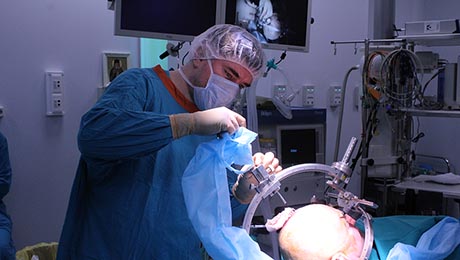
The main task of the Department 19 is to assist the most complex category of patients with neurooncology, including brain tumors, difficult to remove by localization of the median (tumors of the 3rd and 4th ventricles, pineal region, trunk and parastolic department) and basal (tumors of the base of the skull and brain, pituitary adenomas, tumors of the cranial nerves).
In the 19th Department, extensive assistance is provided to patients with vascular neurosurgical pathology (arterial aneurysms, arteriovenous malformations, cavernomas). The department also led and developed assistance to patients with degenerative pathology of the spine (neurosurgical forms of osteochondrosis) with the greatest emphasis on stabilization and diseases of the peripheral nervous system.
Since 2014, local intraoperative irradiation of the removed tumor bed has been used in operations for malignant brain tumors (targeted intraoperative radiation therapy using the INTRABEAM device-Carl Zeiss company). In this direction, the Department has the greatest experience in Moscow.
Since 2002, employees of the Department performed transnasal transsphenoidal endoscopic interventions in patients with pituitary adenomas (access through the nasal passages). Much attention is paid to the development of brain tumor surgery, localized in functionally very important "essential" areas. When manipulating in these structures of the brain, the surgeon requires special pedantry and accuracy with the presence of a neurophysiologist working in the Department, using intraoperative neurophysiological monitoring. For patients with such a complex pathology, a weighted diffusion of MRI is preliminarily carried out with the construction of a navigation system of tractography in the workplace, electromagnetic MR-corography.
The Department is an integral part of the regional vascular center (established in 2013) to provide emergency care to patients with vascular diseases of the brain.
Employees of the Department provide round-the-clock emergency neurosurgical care for acute cerebrovascular disorders (onmc):
Neurosurgical interventions in vascular diseases of the brain, such as arterial aneurysms (without rupture - in the "cold" period), arteriovenous malformations, caverns, as well as operations for revascularization of the brain (the imposition of extracranial microvascular anastomoses) are carried out as planned.
Currently, the Department regularly performs interventions for various diseases of the spine at all levels: herniated discs, spinal stenosis, spondylolisthesis of various etiologies – microsurgical, endoscopic surgery, nucleoplasty, vertebroplasty, high-frequency destruction of facet joints, prosthetics of intervertebral discs, stabilization of the spine with modern titanium metal structures, including percutaneous (percutaneous) installation of stabilizing systems.
Surgical treatment of peripheral nervous system pathology (carpal tunnel syndrome, ulnar canal syndrome, post-traumatic neuropathy, Morton neuroma, peripheral nerve tumors). Operations on the peripheral nervous system are performed with intraoperative neurophysiological monitoring, minimally invasive interventions are carried out under ultrasound control, widely used materials for the prevention of Scar-adhesions in the field of surgery.
Navigation stations have been used regularly since 2007. Traditionally, modern endoscopic methods of surgery of the skull base, ventricular system of the brain are used. The combination of these methods allowed to apply and develop new methods of minimally invasive surgery of tumors and vascular pathology of the brain since 2007. Such operations are variants of Key-Hole operation.
Complex reconstructive operations on the basis of the skull, in particular decompression of the facial nerve canal in fractures of the temporal bone pyramid, are performed only in 19 neurosurgical department.
Today, the Department traditionally provides assistance to patients with nasal liquorrhea (emphasis on minimally invasive endoscopic methods of plastic surgery), Arnold-Chiari syndrome, syringomyelia. The volume of neurosurgical interventions with the use of modern achievements is dynamically expanding.
The developed algorithm of treatment and team work are aimed at an individual approach to each patient and his disease. The work of neurosurgeons is carried out in cooperation with related specialists (otoneurologist, neurophysiologist, neuroophthalmologist, speech therapist, radiologist, neurologist). In the postoperative period, the Department successfully conducts an early recovery program.
The Department annually treats more than 2000 patients, performs up to 600 planned operations per year, annually conducts up to 1000 different studies.
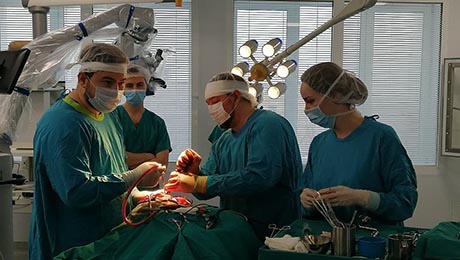
The profile direction of the Department is emergency neurosurgical care for patients with urgent neurosurgical pathology. First of all, the Department is focused on patients with severe craniocerebral trauma, traumatic lesion of the spine and combined pathology. Computed tomography, cerebral angiography and the functional diagnostic service work around the clock.
Surgical interventions are also carried out around the clock. Emergency work is carried out according to standard methods in strict accordance with the necessary algorithms. The use of high-tech invasive (sensors for measuring ICP) and non-invasive (SCT, MRI, EEG, TCD, uzdg BKA) diagnostic methods in the early postoperative period of craniocerebral and spinal injuries, early rehabilitation measures and comprehensive treatment (exercise therapy, massage, speech therapy, psychological service) of patients allowed to reduce the percentage of mortality and improve social adaptation.
Spine injury surgery is performed using modern metallographic structures. Planned surgical interventions are performed using high-tech and minimally invasive approaches: optical microsurgery, endoscopic and ultrasound methods, stereolithographic selection of transplants, selection of shunting systems for the treatment of hydrocephalus.
Equipped with OPMI Vario operating microscope, Stealth Station Medtronic neuronavigation station, neurophysiological equipment (ultrasonic machine, electroencephalograph), endoscopic equipment (Karl Storz), high-frequency burs/craniotome, ultrasonic disintegrator, intraoperative fluoroscopic equipment.
Treatment in a specialized department is carried out in accordance with compulsory medical insurance policies, federal quotas and VHI policies.
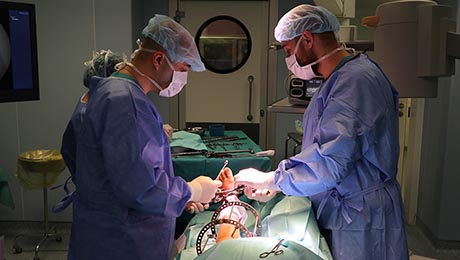
The priority areas of the Department include treatment of osteomyelitis, which combines traumatological and orthopedic profile and the profile of purulent surgery.
Doctors of the Department have extensive experience in the treatment of urgent trauma, severe complicated trauma, complications after all types of operations on the limbs and spine, practice the treatment of General surgical patients with purulent pathology of the limbs.
The Department actively introduces and uses new modern methods of treatment of traumatological and orthopedic patients with septic complications.
Pathologies that are treated in the Department:
The Department uses both traditional methods of treatment and more modern operations, depending on the case.
To traditional methods of treatment include:
New treatments
The Department uses a new method of surgical treatment of hematogenous osteomyelitis of large joints, as well as Purulent coxitis and gonitis - resection of the affected segment and the primary installation of a joint cushion with an antibiotic. Stable positive results were achieved with suppuration of the purulent process and maintaining the function of the joints and limbs.
Operations performed in the Department:
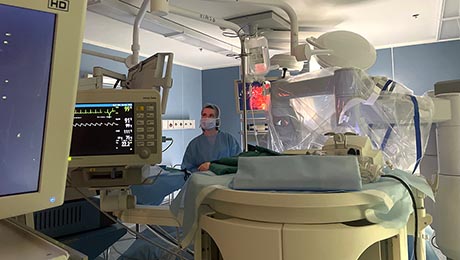
Botkin Hospital is one of the largest medical institutions in Russia, an authoritative scientific and methodological center, occupying a leading position in many important areas of surgery, including thoracic. The thoracic Department of Botkin hospital is the clinical base of the Department of thoracic surgery of the Russian medical Academy of postgraduate education (head of the Department - Professor K. G. Zhestkov).
The hospital is equipped with the most modern diagnostic equipment (ultrasound devices, including for endosonography, fibroendoscopes, CT, MRI, modern complex for x-ray endovascular interventions), which allows for high-precision diagnosis even in the most complex cases of diseases of the chest.
Clinic of thoracic surgery is engaged in scientific and practical development of such important and complex issues as surgery of the trachea and bronchi, esophagus, reconstructive surgery of the lungs, mediastinum and chest wall after surgery. High-tech interventions, including reservoir and video-assisted, are widely used in lung and mediastinal surgery. Along with this, x-ray endovascular surgery is actively used, which allows to detect aneurysms, pathological arteriovenous anastomoses, if necessary, to make stenting or embolization of vessels in order to stop bleeding of various localization or its prevention. Also performed endoscopic stenting of the trachea, bronchi, esophagus in the treatment of stenosis of various etiologies - as a stage in the treatment of tracheosophageal fistulas, which in some cases allows you to abandon the operation.
Currently, there is an increase in the number of patients with diseases of the lungs, mediastinum, chest wall, requiring sometimes complex surgical interventions and high-tech methods of examination and treatment. Botkin Hospital has every opportunity to treat these diseases.
Clinic of thoracic surgery has extensive experience in the treatment of the following diseases:
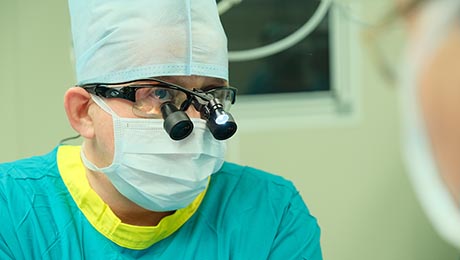
In the Department Of Surgery #46 were created conditions for increased comfort of patients. The Department hospitalized patients surgical profile (General surgery, urology, gynecology, ENT, Traumatology and orthopedics, thoracic surgery, neurosurgery, GLH), requiring a comprehensive examination and surgical treatment.
Treatment of patients with such pathology as:
The Department can conduct a full examination of the patient. It has its own diagnostic service, which includes x-ray room, mammograph, densitometer, endoscopic service, functional diagnostics, ultrasound. It is possible to perform CT and MRI. A full range of laboratory tests, including bacteriological studies, PCR diagnostics. Endoscopic examinations (gastroscopy, colonoscopy, bronchoscopy) are performed under anesthesia.
In the operating unit it is possible to carry out a wide range of surgical interventions, there is video resistance for laparoscopic interventions "Karl Storz", modern equipment necessary for operations (ultrasonic scissors, ligashur, laser). For topical verification of pathological conditions of the liver, bile ducts, pancreas and other internal organs during the operation, diagnostic x-ray, ultrasound and endoscopic examinations are carried out using an electron-optical x-ray Converter, an ultrasonic portable device "Logic-100 General Electric", an endoscopic complex "Olympus". The device has anesthetic and breathing apparatus "Drёger", model"Fabius-GS".
Every year more than 300 patients of surgical profile are examined and treated in the Department, more than 150 operations are carried out.
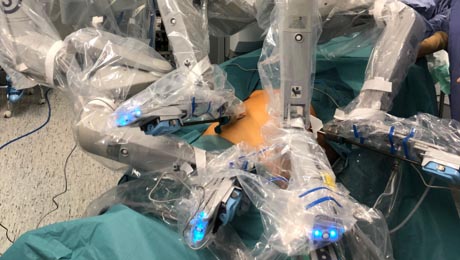
The main directions of Department is treatment of benign and malignant diseases of the abdominal cavity, pelvis and perineum. The priority is the minimum period of hospitalization with maximum effectiveness of treatment. The Department has the most modern medical and diagnostic equipment. As a division of the largest multidisciplinary Botkin hospital, Department of Coloproctology allows to treat patients with concomitant diseases of the heart, respiratory system, musculoskeletal system and endocrine system, to carry out full rehabilitation and activation of patients in the early postoperative period.
In its work, the Department of Coloproctology uses modern diagnostic methods-x-ray, endoscopic, tomographic, sonographic, etc. the operating unit is equipped with modern anesthetic and surgical equipment, which allows to perform including minimally invasive coloproctological operations. Hemorrhoidectomy, excision of the anal fissure, rectal fistula are performed using an ultrasonic scalpel and LigaSure apparatus, Longo operation, anal canal discharge - under the control of ultrasonic Doppler fluorometry.
The Department uses minimally invasive methods of treatment of chronic internal hemorrhoids: latex ligation of hemorrhoids, sclerotherapy, infrared photocoagulation. These methods can reduce the duration of traumatic operations, many times to reduce the intensity of pain in the postoperative period.
The average length of hospital stay after a General operation is 5 days, after cancer surgery – 10-12 days. A promising direction in the work of the Department is the use of laparoscopic techniques in operations in patients with cancer of the colon and rectum.
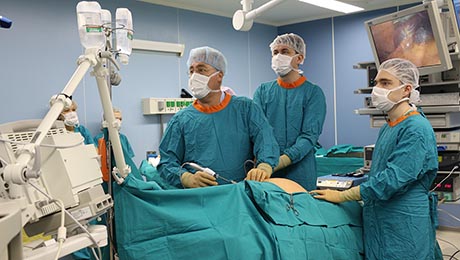
Department of hepatopancreatobiliary surgery, № 50 of Botkin Hospital was founded in 2007 by Professor, doctor of medical Sciences, chief surgeon of the Department of health of Moscow, corresponding member of RAS Alexey Shabunin, who along with the position of chief physician of Botkin Hospital, is the curator of the Department.
The Department provides surgical treatment of benign and malignant diseases of the liver, gallbladder, bile ducts and pancreas, actively using the latest laparoscopic technology.
For years of work of specialized Department the wide experience of application of modern methods of diagnostics is saved up:
All types of low-traumatic methods of treatment are actively used:
Operations are carried out on the surgical robotic complex "DaVinci”:
In recent years, robotic surgery at the most modern robotic surgical complex "DaVinci" is increasingly being introduced into surgical practice.
All our doctors are certified specialists in Oncology. Most surgical interventions on the organs of the hepatopancreatobiliary zone belong to the operations of the highest category of complexity and are performed in several clinics of Russia. Up to 70 pancreatic resections, up to 80 liver resections are performed annually in the Department with the results comparable with the leading European clinics.
The recovery of a patient with liver and pancreatic pathology is the result of the work of a well-coordinated team of specialists. Each patient is discussed at a multidisciplinary consultation chaired by the chief surgeon of Moscow prof. A.V. Shabunin with the participation of hepatopancreatobiliary surgeons, radiologists, chemotherapists, ultrasound doctors, radiologists, therapists, anesthesiologists, and if necessary, specialists of related specialties are involved. All histological studies are conducted by morphologists of expert level under the guidance of the head of pathomorphological Department Prof.
Malignant tumors of the pancreas
The most difficult pathology for the diagnosis and treatment of abdominal cancer is pancreatic cancer. The first priority is the correct diagnosis and elimination of life-threatening complications of the tumor, the most common of which is mechanical jaundice. The most modern method of treatment of mechanical jaundice without incisions and a large operation is the endoscopic installation of special bilioduodenal stents, which restore the normal outflow of bile, leading to an effective resolution of jaundice and making it possible to perform radical surgery.
After diagnosis, further examination and discussion of the tumor, a decision on pancreatic resection is made. With the defeat of the head of the pancreas, pancreatoduodenal resection is performed, supplemented by the removal of all regional lymph nodes that may contain micrometastases of the tumor. It is worth noting that pancreatoduodenal resection is considered one of the most difficult operations in abdominal surgery. With a tumor lesion of the body or tail of the pancreas, various modifications of distal resections are carried out.
The Department developed a unique method of intraoperative radiotherapy. Radical surgery, supplemented by intraoperative radiotherapy, can reduce the incidence of local recurrence of tumors and prolong the life of patients.
In recent years, the Department began to use the most modern laparoscopic and robotic technologies in the treatment of pancreatic cancer. All types of laparoscopic and robotic operations on the pancreas are performed. It should be noted that the activation and discharge of patients operated in this way occurs earlier than in traditional surgery.
Joint work with chemotherapists can improve the results of treatment of patients with pancreatic tumors. To do this, patients receive preoperative chemotherapy, which includes a unique method of administering chemotherapy directly to the pancreatic tumor, as well as systemic chemotherapy in the postoperative period.
Due to this complex and modern approach in patients with pancreatic tumor lesions, the results of their treatment are comparable with the results of the best foreign clinics.
Malignant disease of the liver
Liver resection is the "gold standard" in the treatment of patients with malignant liver diseases. Operating rooms in our clinic are equipped with the most modern equipment to reduce surgical injury and blood loss. This reduces the likelihood of complications and reduces the duration of rehabilitation.
Employees of the Department carry out all kinds of interventions on the liver: from atypical resections to complex operations, when up to 70% of liver tissue is removed. When planning extensive liver resections, to improve their results, the Department uses a unique technology of "growing" liver tissue. This makes it possible to increase the size of a healthy liver parenchyma and perform the necessary major surgery.
Following modern surgical trends, liver operations in our Department are performed using laparoscopy and robotics. Radical surgical interventions are complemented by intraoperative radiotherapy, which reduces the incidence of local recurrence of tumors and improves survival.
Only in several clinics of Russia liver resections are combined with the use of low-traumatic interventions, which can improve the results of treatment of patients.
Resection interventions are complemented by radiofrequency and microwave ablation, which cause the death of tumor cells when their removal during surgery is impossible.
If it is impossible to perform radical operations on the liver in our Department is widely used regional chemotherapy by administering chemotherapy directly to the liver tumor, which allows to extend the life expectancy of inoperable patients.
Cholelithiasis and its complications
The Department has accumulated one of the largest in Russia experience of treatment of patients with cholelithiasis and its complications (choledocholithiasis, Myrrh syndrome, mechanical jaundice). Every year the Department performs more than 800 laparoscopic cholecystectomies, more than 1500 endoscopic interventions on the bile ducts. Operations are performed in less traumatic ways without cuts on the most modern endoscopic equipment by an experienced team of endoscopists.
Acute pancreatitis
One of the most severe diseases of the abdominal cavity is acute pancreatitis and its most severe form is pancreonecrosis. As a rule, mortality in this group of patients ranges from 60 to 80%. Thanks to the developed and implemented in practice modern treatment protocols, this figure is much better - 20-25%. For success in the diagnosis and treatment of acute pancreatitis and pancreonecrosis, the staff of the Department was awarded the prize of the Moscow Government.
Benign diseases of the liver and pancreas
In benign liver diseases (cyst, hemangioma, hepatoma) and parasitic lesions (echinococcosis, alveococcosis), traumatic interventions (biopsy, drainage of fenestraria) are widely used to avoid major abdominal operations. In case of impossibility to avoid surgery laparoscopic and robotic surgical interventions are performed in the Department.
Chronic pancreatitis
The Department has accumulated extensive experience in the treatment of patients with chronic pancreatitis and its complications. Over the past decade, the number of patients with various forms of chronic pancreatitis who have applied to the clinic has increased significantly. According to modern protocols, the Department uses low-traumatic endoscopic and percutaneous interventions to avoid major abdominal operations. These include endoscopic stenting of the pancreatic duct, endoscopic internal drainage of pancreatic cysts (cystogastrostomy). In the Arsenal of the Department there are all modern operations that are used in the surgical treatment of chronic pancreatitis and its complications. The use of modern surgical technologies allows the patient to get rid of pain, return to a normal quality of life, restore the function of the pancreas and liver.
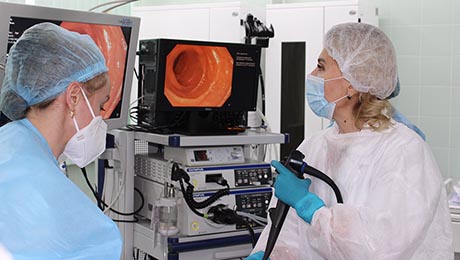
The Department provides emergency and planned care to patients with diseases of the gastrointestinal tract. Comprehensive examination and treatment, in accordance with Russian and international standards, using modern non-invasive, endoscopic and minimally invasive diagnostic methods.
The following studies were carried out:
Treat the following diseases:
For the management of complex patients, specialists from other departments are involved, which allows to reduce the time of diagnostic search and choose the best method of treatment within the walls of one clinic.
Hospitalization of patients in the Department of gastroenterohepatology No. 57 is in the direction of the receiving Department, office, reception planned after the consultation of the gastroenterologist with the clinical-diagnostic polyclinic of Botkin Hospital, transfers from other departments of the hospital.

Department of maxillofacial surgery on the basis of Botkin Hospital was formed within the framework of the Moscow city program of CHI, as well as the Federal program of high-tech medical care. Today, the Department has all the possibilities to provide specialized planned medical care to patients with various types of pathology of the maxillofacial region.
Priority activities of the Department of maxillofacial surgery:
List of operations performed in the Department of maxillofacial surgery:
Due to the high level of professional training and technical equipment, the staff of the Department Of Oral And Maxillofacial Surgery #53 actively use and implement in clinical practice the most effective minimally invasive, including endoscopic and computer technologies.
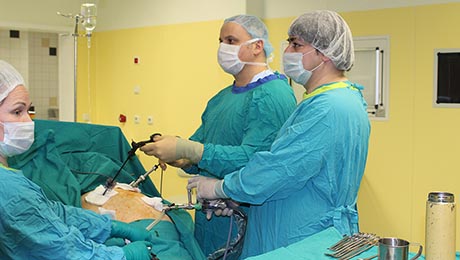
The focus of the department is surgical treatment of urgent conditions and injuries of abdominal organs.
The department has all the facilities for a comprehensive examination of patients, including CT, MRI, angiography and endosonography.
Laparoscopy is widely used for treatment of diseases of the abdominal organs.
There are 30 patient beds in the department. 2-bed and 3-bed patient rooms are equipped with modern functional beds, toilets and showers. Every patient room has a TV set and a refrigerator.

The department performs all types of emergency surgical interventions from laparoscopic appendectomy to open operations for intestinal obstruction and gastrointestinal bleeding.
The procedures are mainly minimally invasive promoting fast healing after the surgeries.
The department provides a full range of examinations for patients with emergency surgical pathology, including ultrasound, X-ray, CT and all types of endoscopy investigations.
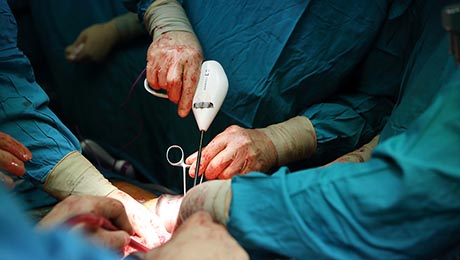
The priority area of the department is abdominal surgery. Our specialists use only state-of-the-art high-tech equipment (bi- and monopolar coagulation, argon plasma coagulation, ultrasonic scalpel, ultrasonic scissors, water-jet dissector, LigaSure, Enseal, and Cell Saver devices), minimizing intraoperative blood loss. Laporoscopy is widely used for treatment of the pathologies of the abdominal organs.

Short-term hospital is promising area of modern medicine, which is very developed abroad and is becoming increasingly popular in Russia. Many operations, which previously required a long stay of the patient in the hospital, are now performed in just one day, thanks to the technical capabilities of the clinic and highly qualified doctors. The Department provides treatment of patients with surgical, urological, gynecological, ENT, orthopedic and traumatological profile.
We use minimally invasive, sparing methods. All procedures and manipulations are carried out according to high European standards, using high-tech equipment of expert class, disposable instruments and the most modern dressings and seams.
